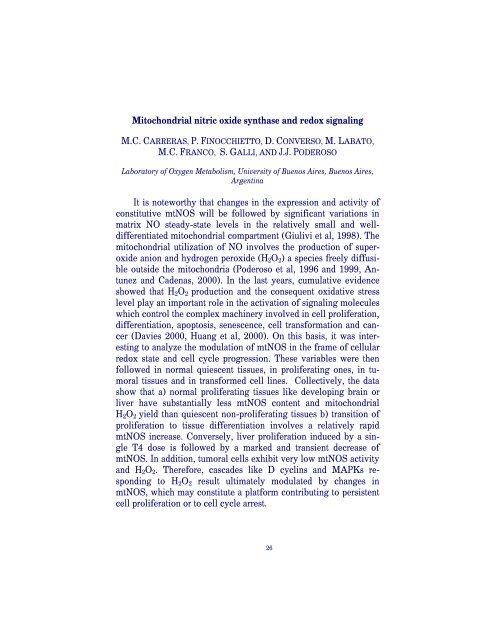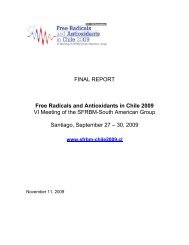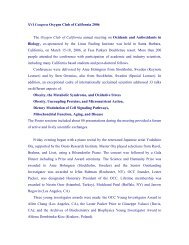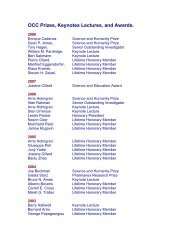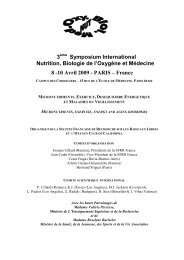oxidants and antioxidants in biology - Oxygen Club of California
oxidants and antioxidants in biology - Oxygen Club of California
oxidants and antioxidants in biology - Oxygen Club of California
Create successful ePaper yourself
Turn your PDF publications into a flip-book with our unique Google optimized e-Paper software.
Mitochondrial nitric oxide synthase <strong>and</strong> redox signal<strong>in</strong>g<br />
M.C. CARRERAS, P. FINOCCHIETTO, D. CONVERSO, M. LABATO,<br />
M.C. FRANCO, S. GALLI, AND J.J. PODEROSO<br />
Laboratory <strong>of</strong> <strong>Oxygen</strong> Metabolism, University <strong>of</strong> Buenos Aires, Buenos Aires,<br />
Argent<strong>in</strong>a<br />
It is noteworthy that changes <strong>in</strong> the expression <strong>and</strong> activity <strong>of</strong><br />
constitutive mtNOS will be followed by significant variations <strong>in</strong><br />
matrix NO steady-state levels <strong>in</strong> the relatively small <strong>and</strong> welldifferentiated<br />
mitochondrial compartment (Giulivi et al, 1998). The<br />
mitochondrial utilization <strong>of</strong> NO <strong>in</strong>volves the production <strong>of</strong> superoxide<br />
anion <strong>and</strong> hydrogen peroxide (H 2 O 2 ) a species freely diffusible<br />
outside the mitochondria (Poderoso et al, 1996 <strong>and</strong> 1999, Antunez<br />
<strong>and</strong> Cadenas, 2000). In the last years, cumulative evidence<br />
showed that H 2 O 2 production <strong>and</strong> the consequent oxidative stress<br />
level play an important role <strong>in</strong> the activation <strong>of</strong> signal<strong>in</strong>g molecules<br />
which control the complex mach<strong>in</strong>ery <strong>in</strong>volved <strong>in</strong> cell proliferation,<br />
differentiation, apoptosis, senescence, cell transformation <strong>and</strong> cancer<br />
(Davies 2000, Huang et al, 2000). On this basis, it was <strong>in</strong>terest<strong>in</strong>g<br />
to analyze the modulation <strong>of</strong> mtNOS <strong>in</strong> the frame <strong>of</strong> cellular<br />
redox state <strong>and</strong> cell cycle progression. These variables were then<br />
followed <strong>in</strong> normal quiescent tissues, <strong>in</strong> proliferat<strong>in</strong>g ones, <strong>in</strong> tumoral<br />
tissues <strong>and</strong> <strong>in</strong> transformed cell l<strong>in</strong>es. Collectively, the data<br />
show that a) normal proliferat<strong>in</strong>g tissues like develop<strong>in</strong>g bra<strong>in</strong> or<br />
liver have substantially less mtNOS content <strong>and</strong> mitochondrial<br />
H 2 O 2 yield than quiescent non-proliferat<strong>in</strong>g tissues b) transition <strong>of</strong><br />
proliferation to tissue differentiation <strong>in</strong>volves a relatively rapid<br />
mtNOS <strong>in</strong>crease. Conversely, liver proliferation <strong>in</strong>duced by a s<strong>in</strong>gle<br />
T4 dose is followed by a marked <strong>and</strong> transient decrease <strong>of</strong><br />
mtNOS. In addition, tumoral cells exhibit very low mtNOS activity<br />
<strong>and</strong> H 2 O 2 . Therefore, cascades like D cycl<strong>in</strong>s <strong>and</strong> MAPKs respond<strong>in</strong>g<br />
to H 2 O 2 result ultimately modulated by changes <strong>in</strong><br />
mtNOS, which may constitute a platform contribut<strong>in</strong>g to persistent<br />
cell proliferation or to cell cycle arrest.<br />
26


